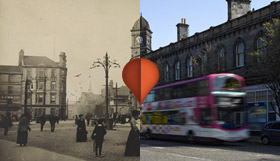SOS. We have struck iceberg. Require assistance. Position 41.46N 50.14W. Titanic
One hundred years ago the world woke up to the shock news that catastrophe had hit the supposedly unsinkable ship, the Titanic. Read the news as it happened with free access to historical newspapers online and get beyond the melodrama of the films and the TV series.
On April 11th 1912, the Shipping Notes in The Scotsman reported on the Titanic’s fateful departure from Southampton Water the previous day. The event marked the “latest progress in shipbuilding” and was watched by large crowds who had gathered to speed the ship on her maiden voyage. An article in The Times following the disaster details how news reached shore in an age before Twitter and mobile phones, and speculates that loss of life would have been far greater had it not been for the recent introduction of Marconi’s wireless apparatus. The newspaper also gives lists of passengers from first and second class ranks. It would later transpire that the majority of casualties came from the crew and third class passengers. The Times relates the disaster to the global economy, with a business report on the New York Stock Market crediting it with the ‘gloom cast over the business world’. Another article on the Mansion House Relief Fund shows how the shock news resonated with people back home. It lists donors and the sums pledged to support the widows and orphans of the passengers and crew starting with His Most Gracious Majesty the King giving £525 to the fund.
Pictures from the Illustrated London News, held by the Reference Library, show the appeal of the Titanic as an opulent floating hotel. There were Turkish baths and swimming baths, a gymnasium, a Parisian-style café, and luxury apartments with private promenade decks. It is not hard to see why people were so eager to take the ship’s first voyage. Companies also wanted to associate themselves with the desirable Titanic brand. The Vinolia Otto Toilet Soap company used a full page advert to state its services to the luxury steamer, “By provision of Vinolia Otto Toilet Soap for first-class passengers the ‘Titanic’ also leads as offering a higher standard of Toilet Luxury and comfort at sea”. Craven tobacco with the unfortunate strapline, “Craven Mixture is a tobacco to live for”, advertised in The Times as being obtainable on the Largest Vessel in the World.
The Illustrated London News also recalls the human side of the story, with artist impressions drawn from survivors’ accounts of the moments after tragedy struck and pictures of the survivors who arrived safely back in Plymouth. One poignant reminder of a bygone era shows the engine room stokers calmly waiting their turn as women and children boarded lifeboats first as the boat was sinking fast. Dramatic pictures illustrate the catastrophic moment the enormous ship sank into two miles of water. Read a tribute to Wallace Henry Hartley, the ship’s bandleader, who together with fellow musicians played on deck throughout the evacuation. They played it is alleged until waist deep in water. All 8 of the musicians perished in the disaster, yet their part in the dreadful night is remembered still.

Of the 2224 passengers and crew on board, more than 1500 died. Find the true story behind the legend and read the news as it unfolded with The Scotsman Digital Archive and The Times Online. (The Scotsman Digital Archive is available from home. The Times Online is available to readers from the Reference Library at Central Library.)
Visit the Reference Library in April and see our fascinating display showcasing pictures and literature from our collections about the story of the Titanic.
 We’ve just launched a brand new version of Your Library, Edinburgh Libraries’ gateway site to all our online resources and services. Your Library features links to more than fifty sites and apps, making it easier than ever for library members to find information, learn new skills and pursue their interests.
We’ve just launched a brand new version of Your Library, Edinburgh Libraries’ gateway site to all our online resources and services. Your Library features links to more than fifty sites and apps, making it easier than ever for library members to find information, learn new skills and pursue their interests. We’ve just launched a brand new version of Your Library, Edinburgh Libraries’ gateway site to all our online resources and services. Your Library features links to more than fifty sites and apps, making it easier than ever for library members to find information, learn new skills and pursue their interests.
We’ve just launched a brand new version of Your Library, Edinburgh Libraries’ gateway site to all our online resources and services. Your Library features links to more than fifty sites and apps, making it easier than ever for library members to find information, learn new skills and pursue their interests.





